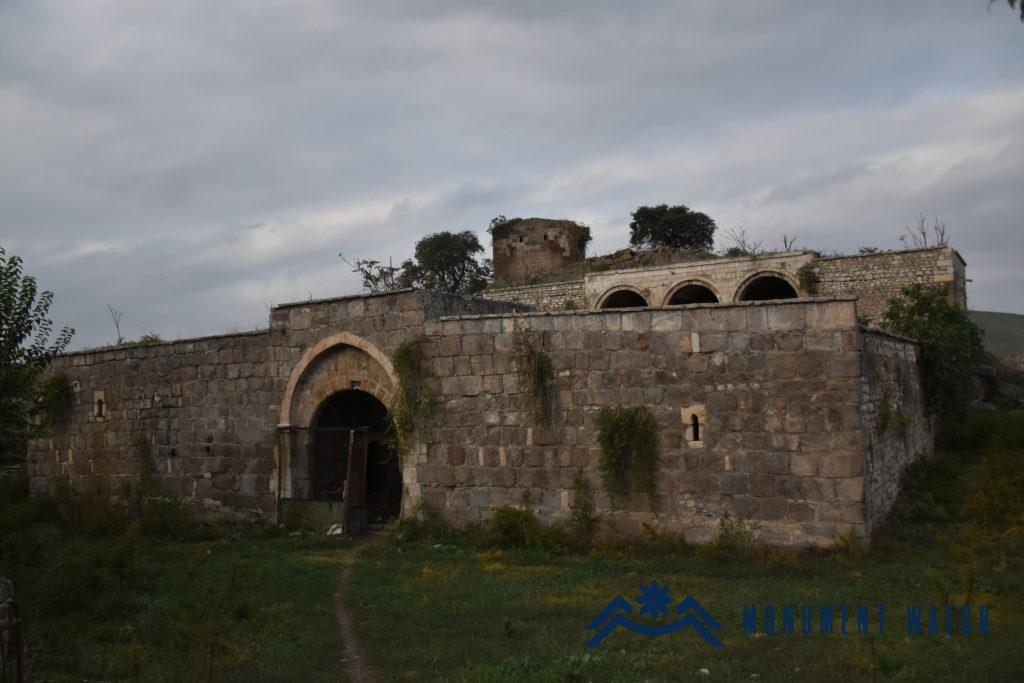Gharghabazar: caravanserai and mosque
Location The caravanserai and the mosque are located in Hadrut region of the Artsakh Republic, and during the Soviet years they used to be within the borders of Gharghabazar village in Fizuli region of the Azerbaijani SSR. As a result of the 2020 hostilities, the area where the monument group is located, has passed under Azerbaijani control. Historical overview Historical data about the monument is quite scarce. The caravanserai is considered to have been built in the 17th century (Усейнов 1963, 291). The mosque, located on the top of the hill, according to the inscription above the entrance, was built by Haji Gias ad-Din in 1683/1684 (КЭПА 2011, 96-97). Architectural-compositional description The caravanserai is located on the western slope of a hill rising in the center of the village. During its construction the nature of the terrain was taken into account: the relief is left unchanged and the structures are adapted to it (Fig. 1). The building of the caravanserai is rectangular in the plan, the courtyard is located in the center, around which the complex is formed with buildings of different significance (Fig. 2). This layout, in which the courtyard plays a central role, was quite common in the caravanserais of the region. The caravanserais of Nerkin Talin and the former Atarbekyan village (now Hrazdan city) are among the caravanserais with courtyard in Armenia, such was the caravanserai of the capital Ani, etc. (Harutyunyan 1992, 342, 346-348). In the works dedicated to the history of the architecture of Azerbaijan, such caravanserais with a rectangular plan and courtyard are divided into two types: urban and road, and the caravanserai of Gharghabazar is classified among the type of road caravanserais (Саламзаде 1964, 63-67). Two long, vaulted halls for animals (Figs. 3, 4) are situated to the right and left of the caravanserai entrance (Бретаницкий 1966, 279). These halls are half-underground, vaulted, have stables and fireplaces. The arches of the three-arched vestibule (Fig. 5) are horseshoe-shaped and have their direct parallels in the architecture of medieval Artsakh (Metsaran Monastery, Koshik Hermitage). Behind the vestibule there is a spacious hall, next to which there are single-nave vaulted chambers. The central hall and the vaulted chambers are entirely located inside the hill and are not visible from the outside: when approaching the monument, one can see only the three-arched hall and the outer walls of the adjacent chambers (Mkrtchyan 1985, 138). Most of the buildings are externally built of uncut stones, the parlours, chambers and the portal – with polished stones. There is an Armenian commemorative inscription on the pillar of the central arch of the vestibule: “I – Jli Vard, came in the year of 1681…” (CAE 1982, 191). The building of a single-nave mosque with a vaulted roof is situated on the top of the hill, it is built of polished gray stone, has rather thick walls and a rectangular composition (Fig. 6), whose main entrance is on the northern side, and the Arabic building inscription is situated just above the entrance (Fig. 7). The mosque has three windows: one on the northern side, just above the inscription, and the other two on the southern facade (Fig. 8). The building has small niches inwardly, and in front of the entrance, in the south, there is a mihrab (Fig. 9). The building of the mosque, with its layout principles, even with its external and internal view, except for the mihrab, reproduces the single-nave, vaulted churches that were widespread in Artsakh in the Late Middle Ages. The condition before and after the war The caravanserai building and the mosque have not been damaged during the Artsakh wars. The monument group was not intentionally destroyed or subjected to modifications. We can only state that, based on the dimensions and accomodations of the caravanserai building, grass was stored there, of which the monument was not damaged.
